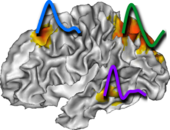pyhrf.sandbox.stats module¶
-
class
pyhrf.sandbox.stats.GSVariable(name, initialization, do_sampling=True, axes_names=None, axes_domains=None)¶ -
check_against_truth(atol, rtol, inaccuracy_handling='print')¶
-
check_initialization_arg(ia)¶
-
enable_sampling(flag=True)¶
-
get_accuracy_against_truth(abs_error, rel_error, fv, tv, atol, rtol)¶ Return the accuray of the estimate fv, compared to the true value tv
-
get_custom_init()¶ Must return a numpy.ndarray. Consider initializing with a good guess so that sampling converges more quickly.
-
get_estim_value_for_check()¶
-
get_random_init()¶ Must return a random numpy.ndarray that will then be used as init value for sampling. For example, it can be a sample from the prior distribution. This function will also be used to test for the sensitivity to initialization.
-
get_true_value_for_check()¶
-
get_variable(vname)¶
-
get_variable_value(vname)¶ Short-hand to get variable among all those defined in the parent sampler
-
init_observables()¶
-
init_sampling()¶
-
reset()¶
-
sample()¶ Draw a sample conditionally to the current Gibbs Sampler state. Must return a numpy.ndarray.
Variables which have been registered in the parent GibbsSampler object can be retrieved via methods self.get_variable(var_name) and self.get_variable_value(var_name)
-
set_init_value()¶ Set the initial value of self.current_value, depending on the initialization scenario (random, custom, truth).
-
set_initialization(init)¶
-
set_outputs(outputs, output_type='ndarray')¶ Parameters: - outputs (-) – dictionary to be updated with custom outputs.
- output_type (-) – ‘ndarray’ or ‘cuboid’
Return: None
-
set_true_value(true_value)¶
-
track_obs_quantity(name, quantity, history_pace=None, axes_names=None, axes_domains=None)¶
-
track_sampled_quantity(name, quantity, history_pace=None, axes_names=None, axes_domains=None)¶
-
update_observables()¶ Update quantities after the burnin period
-
-
class
pyhrf.sandbox.stats.GibbsSampler(sampled_variables, nb_its_max, obs_pace=1, burnin=0.3, sample_hist_pace=-1, obs_hist_pace=-1)¶ -
check_against_truth(default_atol=0.1, default_rtol=0.1, var_specific_atol=None, var_specific_rtol=None, inaccuracy_handling='print')¶
-
get_outputs(output_type='ndarray')¶ output_type : ‘ndarray’ or ‘cuboid’
-
get_variable(vname)¶
-
get_variable_value(vname)¶
-
iterate_sampling()¶
-
reset()¶ - Reset the Gibbs Sampler:
- remove all previous history of quantities (trajectories)
- call reset method of all variables
-
run()¶
-
set_initialization(vname, init)¶
-
set_true_value(vname, true_value)¶
-
set_true_values(true_values)¶
-
set_variable(name, var)¶
-
set_variables(var_dict)¶
-
stop_criterion(iteration)¶
-
track_obs_quantity(name, q, history_pace=None, axes_names=None, axes_domains=None)¶
-
track_sampled_quantity(name, q, history_pace=None, axes_names=None, axes_domains=None)¶
-
-
class
pyhrf.sandbox.stats.Trajectory(variable, history_pace, history_start, max_iterations, init_iteration=None, axes_names=None, axes_domains=None)¶ Keep track of a numpy array that is modified _inplace_ iteratively TODO: when mature, should be moved to pyhrf.ndarray
should replace pyhrf.jde.samplerbase.Trajectory-
get_last()¶ Return the last saved element
-
to_cuboid()¶ Pack the current trajectory in a xndarray
-
update(iteration)¶ Record the current variable value
-


